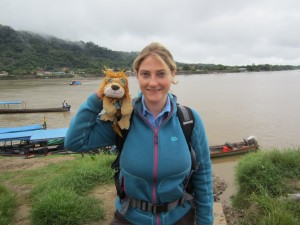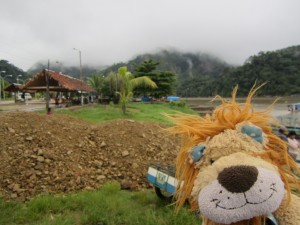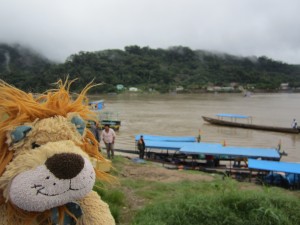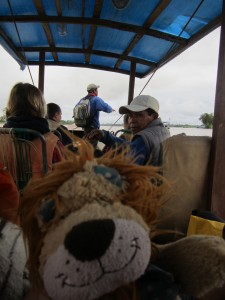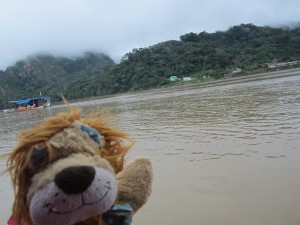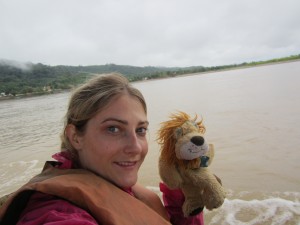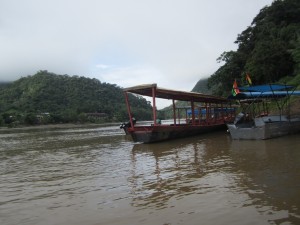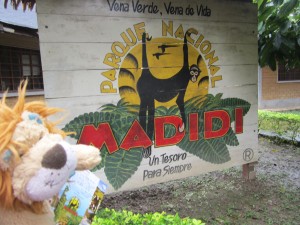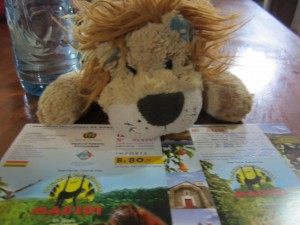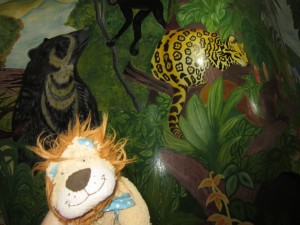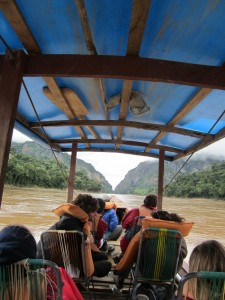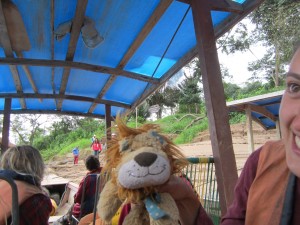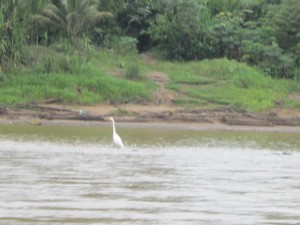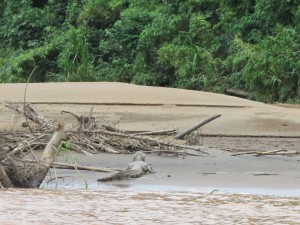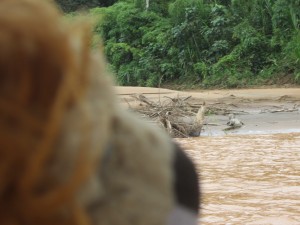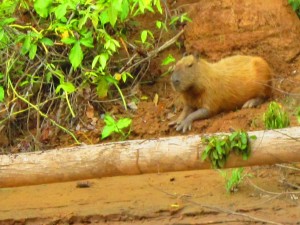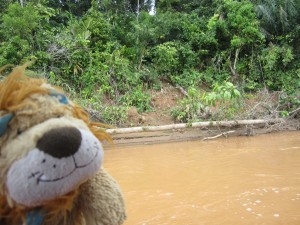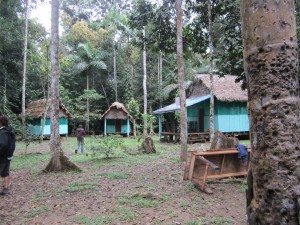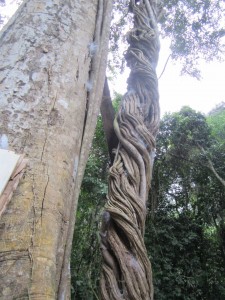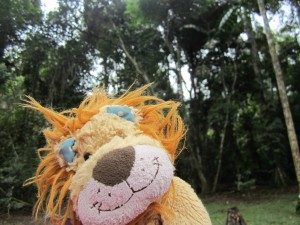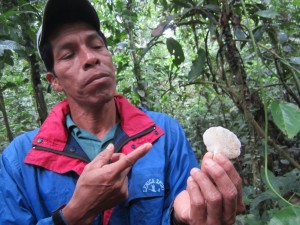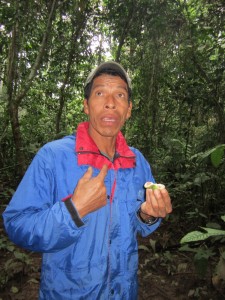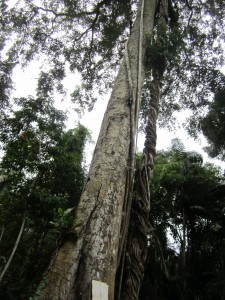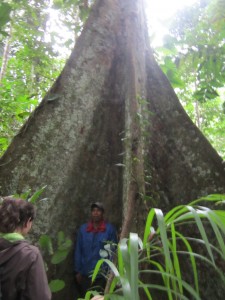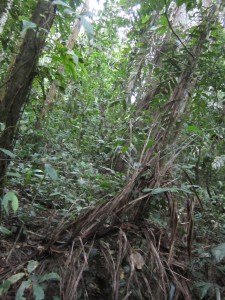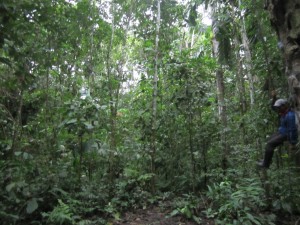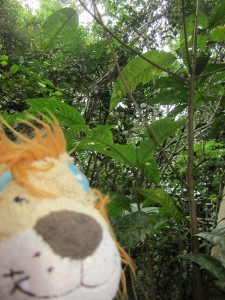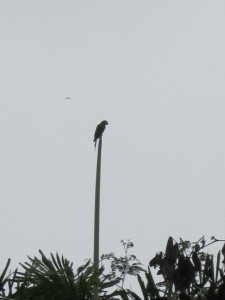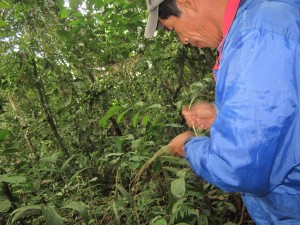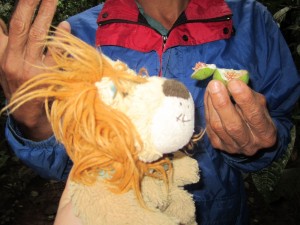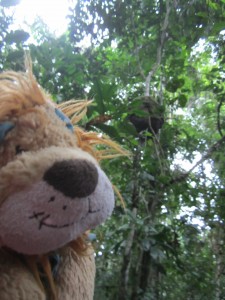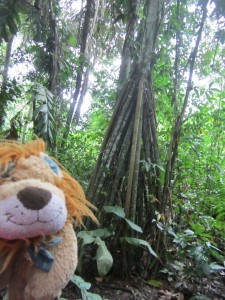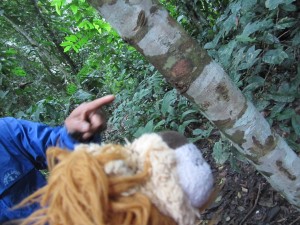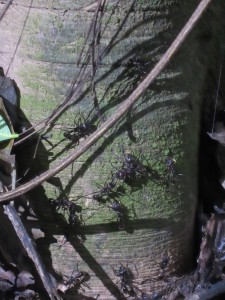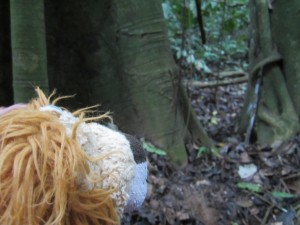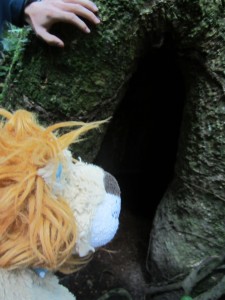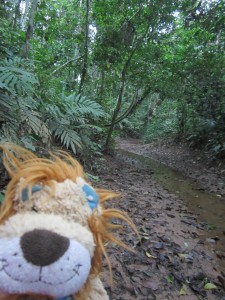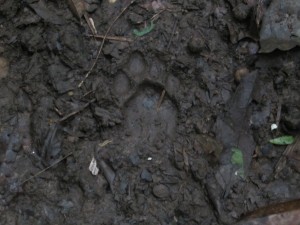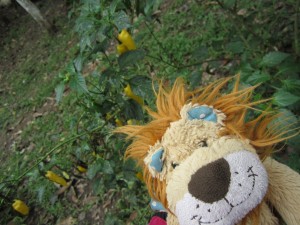Lewis and Helen were accompanied down to the River Beni by the lovely travel agent.
The day was overcast and yet there was a hive of activity from the boats by the side of the river.
There was no landing platform, rather just a muddy bank you had to try to get down without falling over and get yourself into the elongated motor-boat. Helen had her small rucksack and had been given a sleeping bag in a white drawstring bag. She only hoped that she didn’t drop it in the mud as she stumbled into the boat. Luckily one of the crew held their hand out to help Helen and Lewis on to the boat. The boat was banana shaped with a blue tarpaulin covering the top with seats running along either side. The first thing that Helen did was hand her bags over for the crew to safely pack them away under another tarpaulin sheet at the back of the boat. She then sat on a seat and put on her life-jacket. Some more tourists got on the boat too and did the same. There were 10 in all, plus 5 members of team (2 expert trackers, a cook and 2 men to steer the boat).
As the motorboat left the sleepy town of Rurrenabaque, picking up speed as it zipped along the River Beni towards the Madidi National Park, Lewis the Lion couldn’t help but grin to himself: they were going to the Amazon! How cool was that?!
Click here to see Lewis whizzing along in the motorboat.
They hadn’t travelled far up the river when they stopped to go and buy a permit to visit the Park Madidi.
This is because this park lies in a protected area of the Amazon Rainforest.
Lewis the Lion was more than happy for Helen to fill in the required forms as he thinks it is very important that the rain-forests are protected.
After all they contain thousands of species of animals and varieties of plants, trees and vegetation and contribute massively to the production of the planet’s oxygen.
As the boat chugged along for a couple of hours, Lewis the Lion spotted many wading birds with long legs and long beaks. He thought one wading bird looked like it had a pair of shears for its beak!
Other birds too flew overhead, including raucous macaws and swooping vultures. On a sandy bank, Lewis even spotted an alligator who seemed to be taking an afternoon rest!
At one point, one of the trackers on board spotted a rather peculiar animal on the banks of the river and the boat slowed down for the jungle adventurers to take a look.
Lewis the Lion had never seen nor heard of this animal before: a capybara. It looked like a cross between a giant rat and a beaver! In fact it is the largest species in the rodent family.
Not long afterwards, (after a few hairy moments when the boat nearly got stuck on the rocks!)
the group eventually arrived at the side of a muddy bank from which led a path to the jungle encampment. It was like a conveyor belt as goods from the boat were passed from person to person along the line. By this point, Lewis’ little belly was rumbling: he was very hungry but he would have to wait a bit longer before the cook had managed to prepare food for all the group. The jungle encampment was really rather charming.
In a clearing there were several thatched huts on platforms, with planks of wood between each one to save you walking in the mud. As Lewis the Lion turned 360 degrees, he smiled to himself: he just loved the fact that they were in the middle of the forest with enormous high trees and vines everywhere he looked! There was even one vine near the huts that Lewis the Lion thought looked just like a tress of Rapunzel’s hair. What do you think?
The welcomed lunch arrived at 2:45 pm. The fantastic cook had prepared chicken, rice, salad and beans for the group. After which, the group felt ready to go and explore the forest that awaited them. How exciting!
The forest guide or tracker that led Lewis’ group had grown up in the forest as part of the native Tacan tribe. Even though he spoke in Spanish, he also used Tacan words to describe many of the delights of the forest around them. He told Lewis how his father used to take him into the forest as a young child and teach him about the properties of the plants and trees around him; the way his grandfather had done with his own father. In this way, the knowledge of the forest was passed down from generation to generation and Lewis’ guide certainly seemed to know a lot about the forest around him. Lewis the Lion was simply amazed at the guide’s sense of orientation: there seemed no chance of him getting lost in this forest.
The first golden rule that the guide told the group was the importance of listening to the sounds of the forest. The sounds around you held many clues to the type of animals that might be lingering close by.
However, Lewis the Lion soon realised that all of the senses would be evoked in the forest, in some instances even taste! But for now, Lewis followed the tracker as quietly as he could. The tracker led the way snipping off branches with a sharp knife as he went to allow the group safe passage. At times he would stop abruptly and cock his ear as if listening for those clues. Lewis would follow his gaze. And then maybe he’d just continue on again. Click here to see a clip.
Lewis the Lion wanted to pinch himself as he walked through the forest and craned his neck to look up at the tallest trees he had ever seen in his little life.
See this photo of the guide stood beside one such tree.
The forest was just so dense and rich in such a wide variety of trees and plants.
He couldn’t have imagined so many different types in his wildest dreams.
Unfortunately, rather like the previous day in Rurrenabaque, the weather had not dramatically improved and although it was dry, the day was grey and cold. The guide told the group that this was unusual and it might hamper their chances of seeing too many animals but Lewis the Lion didn’t mind: he was just happy to be here at all and see the Amazon Rainforest for himself with his own little eyes!
Just as Lewis the Lion was thinking how lucky he was, the guide stopped all of a sudden and motioned to the group to listen. They could hear clear bird calls above their heads. He then proceeded to mimic the calls of these parrots, macaws to be precise, and Lewis was surprised to see that more and more birds seemed to respond to the tracker’s calls by flying directly overhead.
Watch how the tracker calls to these birds high above the forest.
Can you see the macaws flitting from tree to tree as the tracker continues to call them? See a short clip here.
Because of the poor light, the tracker told the group that you couldn’t see the colours of these birds so vibrantly as usual but Lewis the Lion was just happy to have seen them at all. Here is a photo which he took of a macaw (a type of parrot) resting on the top of a tree.
The group continued to trek through the forest, from time to time stopping for the guide to tell them all sorts of interesting secrets of the forest. For example, he showed them how a type of vine, the miti, is so strong that it can be used to carry things and he made a water carrier for a bottle of water!
He showed them fruits that Lewis the Lion had never seen before that animals would feed off, e.g. bibosi.
He showed them if you burnt the bark of a termites’ nest, the smoke could be used in the treatment of sting-ray bites and Lewis the Lion thought it was incredible that anybody would know this sort of thing in the first place!
He also showed them plants that if you rubbed with some water would produce a natural dye which the natives could then use.
There were many surprises in the forest including a type of tree where the roots grow above ground to give the tree more chance of competing for the sunlight above, the Palmera Pachua.
Lewis thought it looked like the trees might be able to walk and thought that their bases looked a little bit like a broomsticks. He was reminded of the Walt Disney film, the Sorcerer’s Apprentice when the broomsticks come to life and wondered if that would ever really happen in the forest too?!
The tracker pointed out a tree called the palo de diablo where termites lived and a little further along showed the group a tree with the biggest ants Lewis the Lion had ever seen in his life!
He definitely didn’t want to get too close!
Nor did he want to get too close to a tree which was the home to lots of bats in case they came flying out!
As well as listening to the sounds of the forest, the tracker showed how important it was to observe the forest floor as you walked along.
Due to the fact it had been so wet was actually an advantage, as lots of animals had left muddy paw prints on the ground, including this rather impressive paw-print of a puma.
Other paw-prints that Lewis saw included tapir’s and wild boar.
Towards the end of their forest exploration for the afternoon, the guide showed the group what fun could be had in the forest by swinging on a vine just like Tarzan! This parasite vine called matopalo is also very strong. Click here to have a look.
The group then returned to the camp, just as it was getting dark.
It was time to make sure that the mosquito nets were firmly attached around their bed frames and get their torches out as their was no electricity or wifi in the heart of the jungle. Lewis the Lion thought that it made a refreshing change that there really are still places in this world where you can get away from it all!
The nighttime would hold yet more delights as Lewis the Lion and the group went on a stroll through an increasingly wet forest. Lewis saw an alligator, a fawn, birds and several enormous frogs. What a day it had been as he collapsed into his sleeping bag under his mosquito net! The pitter-patter of the raindrops against the roof of the hut soon lulled him to sleep.
What do you know about rainforests already?
Is it a place you would like to visit? Why or why not?

